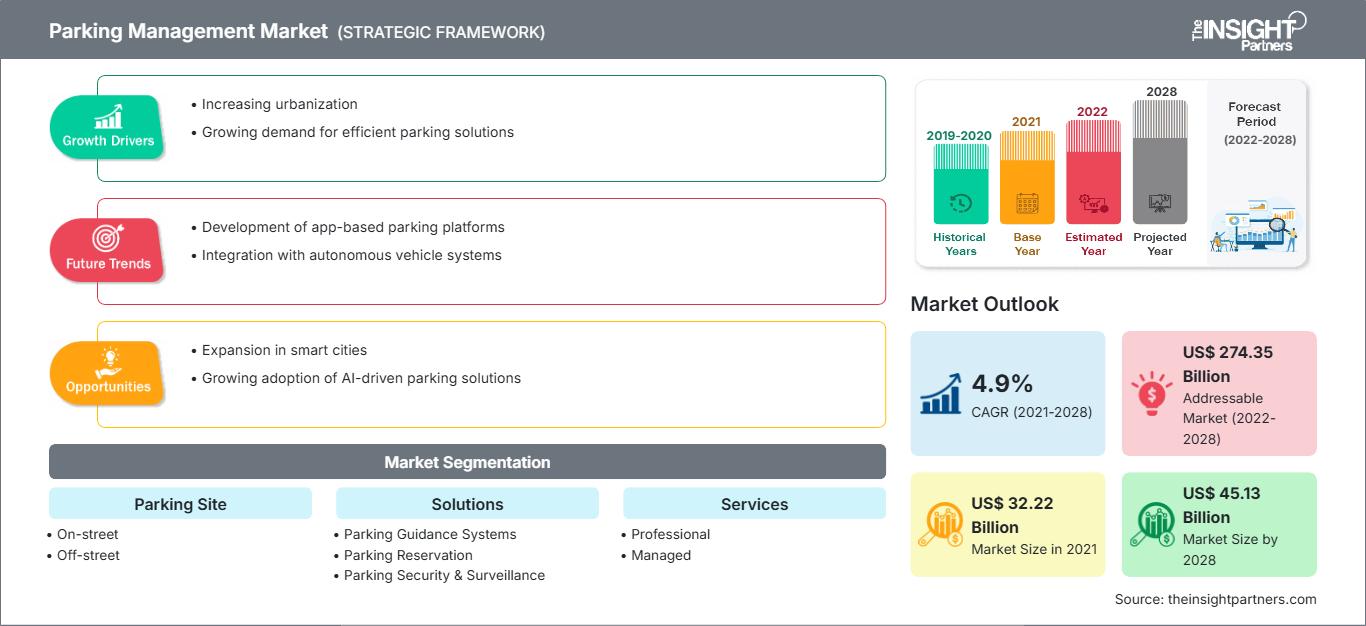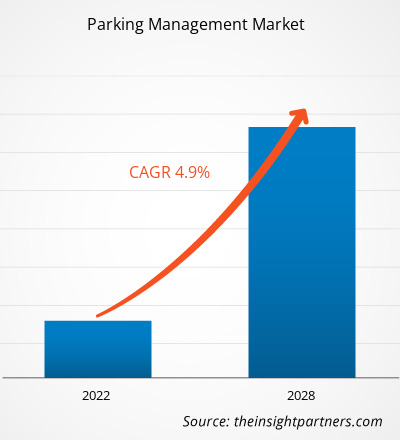Se prevé que el mercado de gestión de estacionamientos crezca de 32.221,73 millones de dólares estadounidenses en 2021 a 45.125,82 millones de dólares estadounidenses en 2028; se estima que crecerá a una tasa de crecimiento anual compuesta (TCAC) del 4,9% durante el período 2021-2028.
Las principales ciudades de varios países del mundo están adoptando ampliamente tecnologías inteligentes con el objetivo de reducir los problemas cotidianos de tráfico y aparcamiento. El tráfico y la disponibilidad de aparcamiento han sido problemas persistentes tanto en regiones desarrolladas como emergentes a nivel mundial. Actualmente, las tecnologías de aparcamiento inteligente están revolucionando la gestión de aparcamientos, y la demanda de estas tecnologías crece exponencialmente. Entre las tecnologías inteligentes que experimentan un crecimiento extraordinario en los sistemas de gestión de aparcamiento actuales se incluyen los sistemas de información de guiado de aparcamiento, el aparcamiento automatizado, los sistemas inteligentes de pago de aparcamiento y los sistemas de reserva de aparcamiento. Además de estas tecnologías, la demanda de seguridad para los vehículos aparcados también está aumentando rápidamente entre los conductores y propietarios, lo que impulsa la adquisición de sistemas de vigilancia de aparcamiento y, por consiguiente, crea un amplio mercado para el crecimiento de las empresas de gestión de aparcamiento en los próximos años.
Impacto de la pandemia de COVID-19 en el mercado de gestión de estacionamientos
La pandemia de COVID-19 ha sacudido diversas industrias en todo el mundo. El confinamiento obstaculizó las operaciones de varios sectores, incluyendo el manufacturero y el de TI. Sin embargo, industrias esenciales como la de bienes de consumo de alta rotación ( FMCG ) y la farmacéutica tuvieron que continuar operando. El brote ha provocado interrupciones en industrias primarias como la electrónica, los semiconductores y la automotriz. Una fuerte caída en el crecimiento de dichas industrias está limitando el crecimiento del mercado de gestión de estacionamientos. El cierre de fábricas, las prohibiciones de viajes y comercio, y el cierre de fronteras para combatir y contener la infección han impactado el funcionamiento de muchos edificios comerciales y corporativos en todo el mundo. Actualmente, Estados Unidos es el país más afectado por el brote de COVID-19. La mayoría de las entidades públicas y municipios dependen de los impuestos y los ingresos por estacionamiento para financiar importantes proyectos para los ciudadanos. Los edificios corporativos, los centros financieros , las universidades, los centros comerciales, los hospitales, los hoteles, los aeropuertos y muchos otros cuentan con amplias instalaciones y servicios de estacionamiento para gestionar eficientemente sus operaciones. Debido al impacto de la pandemia de COVID-19, las diversas actividades y el mantenimiento del distanciamiento social para frenar la propagación del virus, el sector de los estacionamientos se ha visto gravemente afectado. Muchas empresas han estado bajo una enorme presión para sobrevivir y cientos de miles de trabajadores esenciales están perdiendo sus empleos. Se realiza un seguimiento en tiempo real de la dinámica de más de 2000 estacionamientos en toda Norteamérica, así como observaciones para comprender mejor cuantitativamente el impacto de la COVID-19 en el sector.
Obtendrá personalización gratuita de cualquier informe, incluyendo partes de este informe, análisis a nivel de país y paquetes de datos de Excel. Además, podrá aprovechar excelentes ofertas y descuentos para empresas emergentes y universidades.
Mercado de gestión de estacionamientos: Perspectivas estratégicas

-
Obtenga las principales tendencias clave del mercado que se describen en este informe.Esta muestra GRATUITA incluirá análisis de datos, que abarcarán desde tendencias de mercado hasta estimaciones y pronósticos.
Perspectivas del mercado de gestión de estacionamientos
Fomentar las alianzas y fusiones para impulsar la gestión del estacionamiento en zonas urbanas
El mercado global de sistemas de gestión de estacionamientos está altamente fragmentado, con la presencia de numerosos actores que operan en el sector con sus respectivas tecnologías y servicios. Esto ha generado una considerable complejidad para los usuarios finales de dichos sistemas. La necesidad y la demanda de sistemas de gestión de estacionamientos tecnológicamente avanzados aumentan continuamente tanto en las regiones desarrolladas como en las emergentes de todo el mundo. Los actores del mercado de gestión de estacionamientos tienen una importante oportunidad de crecimiento en el futuro cercano mediante alianzas con otros proveedores de servicios de gestión de estacionamientos y gobiernos. Estas alianzas entre proveedores de servicios facilitan la prestación de servicios personalizados, lo que se espera que impulse significativamente el mercado. Por ejemplo, en julio de 2021, Passport habilitó el pago de estacionamientos directamente a través del sistema de infoentretenimiento Uconnect en vehículos Chrysler, Dodge, Jeep y Ram, gracias a una alianza con Xevo, líder en tecnologías para vehículos conectados y experiencias de usuario innovadoras. De manera similar, en 2020, T2 Systems, una empresa de tecnología de estacionamiento, colaboró con TEZ, los creadores de TEXT2PARK, para ofrecer T2 MobilePay, una solución de pago de estacionamiento móvil que brinda a los usuarios un método fácil y conveniente para pagar el estacionamiento en sus teléfonos celulares, al tiempo que otorga a los operadores el control sobre sus datos e ingresos.
Información de mercado basada en sitios de estacionamiento
Según el tipo de estacionamiento, el mercado global de gestión de estacionamientos se divide en estacionamiento en la vía pública y estacionamiento fuera de la vía pública. En 2020, el segmento de estacionamiento fuera de la vía pública lideró el segmento de estacionamiento en la vía pública y representó la mayor cuota de mercado.
Perspectivas de mercado basadas en soluciones
Según el tipo de solución, el mercado de gestión de estacionamientos se segmenta en soluciones de guiado, reserva, seguridad y vigilancia, y otras. En 2020, el segmento «otros» lideró el mercado y representó la mayor cuota de mercado.
Perspectivas del mercado basadas en servicios
Según los servicios ofrecidos, el mercado de gestión de estacionamientos se divide en servicios gestionados y servicios profesionales. En 2020, el segmento de servicios gestionados lideró el mercado de gestión de estacionamientos y representó la mayor cuota de mercado.
Perspectivas de mercado basadas en el despliegue
Según el tipo de implementación, el mercado de gestión de estacionamientos se divide en soluciones en la nube y soluciones locales. En 2020, el segmento de soluciones locales lideró el mercado de gestión de estacionamientos y representó la mayor cuota de mercado.
Las empresas que operan en el mercado de la gestión de estacionamientos adoptan estrategias como fusiones, adquisiciones e iniciativas de mercado para mantener su posición. A continuación, se enumeran algunas de las novedades de los principales actores:
- En agosto de 2021, el software Mobile Enforcement Software (MEA) de T2 Systems, una aplicación para emitir citaciones para iPhones, iPads y tabletas Android, ahora interactúa con el sistema de reconocimiento automático de matrículas (ALPR) AutoVu de Genetec, lo que proporciona a las operaciones de estacionamiento una solución de control móvil basada en LPR.
- En agosto de 2021, ParkMobile, la aplicación móvil de estacionamiento número 1 en EE. UU., anunció un nuevo acuerdo de colaboración estratégica con TIBA Parking Systems, miembro del grupo FAAC, el mayor fabricante de sistemas de gestión de estacionamientos en Norteamérica, para ofrecer opciones de pago sin contacto en estacionamientos con barrera. El mercado global de gestión de estacionamientos se segmenta de la siguiente manera:
Perspectivas regionales del mercado de gestión de estacionamientos
Los analistas de The Insight Partners han explicado en detalle las tendencias y los factores regionales que influyen en el mercado de la gestión de estacionamientos durante el período de previsión. Esta sección también analiza los segmentos y la geografía del mercado de la gestión de estacionamientos en Norteamérica, Europa, Asia Pacífico, Oriente Medio y África, y Sudamérica y Centroamérica.
Alcance del informe de mercado de gestión de estacionamientos
| Atributo del informe | Detalles |
|---|---|
| Tamaño del mercado en 2021 | 32.220 millones de dólares estadounidenses |
| Tamaño del mercado para 2028 | 45.130 millones de dólares estadounidenses |
| Tasa de crecimiento anual compuesto global (2021 - 2028) | 4,9% |
| Datos históricos | 2019-2020 |
| período de previsión | 2022-2028 |
| Segmentos cubiertos |
Por el sitio de estacionamiento
|
| Regiones y países cubiertos |
América del norte
|
| Líderes del mercado y perfiles de empresas clave |
|
Densidad de los actores del mercado de gestión de estacionamientos: comprensión de su impacto en la dinámica empresarial
El mercado de gestión de estacionamientos está creciendo rápidamente, impulsado por la creciente demanda de los usuarios finales debido a factores como la evolución de las preferencias de los consumidores, los avances tecnológicos y una mayor conciencia de los beneficios del producto. A medida que aumenta la demanda, las empresas amplían su oferta, innovan para satisfacer las necesidades de los consumidores y aprovechan las nuevas tendencias, lo que impulsa aún más el crecimiento del mercado.

- Obtenga una visión general de los principales actores del mercado de gestión de estacionamientos.
Por el sitio de estacionamiento
- En la calle
- Fuera de la calle
Por soluciones
- Sistemas de guía de estacionamiento
- Reserva de estacionamiento
- Seguridad y vigilancia de estacionamientos
- Otros
Por servicios
- Servicios gestionados
- Servicios profesionales
Por tipo de implementación
- Nube
- En las instalaciones
Por geografía
-
América del norte
- A NOSOTROS
- Canadá
- México
-
Europa
- Francia
- Alemania
- Italia
- Reino Unido
- Rusia
- El resto de Europa
-
Asia Pacífico (APAC)
- Porcelana
- India
- Corea del Sur
- Japón
- Australia
- Resto de Asia Pacífico
-
Oriente Medio y África (MEA)
- Sudáfrica
- Arabia Saudita
- Emiratos Árabes Unidos
- Resto de Oriente Medio y África
-
Sudamérica (SAM)
- Brasil
- Argentina
- El resto de SAM
Perfiles de empresas
- Grupo Flowbird
- PASSPORT LABS, INC.
- T2 Systems, Inc
- SISTEMAS DE ESTACIONAMIENTO TIBA
- Grupo Índigo
- ParkLink preciso
- FlashParking
- Corporación Amano
- Robert Bosch GmbH
- Siemens AG
- Análisis histórico (2 años), año base, pronóstico (7 años) con CAGR
- Análisis PEST y FODA
- Tamaño del mercado, valor/volumen: global, regional y nacional
- Industria y panorama competitivo
- Conjunto de datos de Excel
Informes recientes
Informes relacionados
Testimonios
Razón para comprar
- Toma de decisiones informada
- Comprensión de la dinámica del mercado
- Análisis competitivo
- Información sobre clientes
- Pronósticos del mercado
- Mitigación de riesgos
- Planificación estratégica
- Justificación de la inversión
- Identificación de mercados emergentes
- Mejora de las estrategias de marketing
- Impulso de la eficiencia operativa
- Alineación con las tendencias regulatorias






















 Obtenga una muestra gratuita para - Mercado de gestión de aparcamientos
Obtenga una muestra gratuita para - Mercado de gestión de aparcamientos